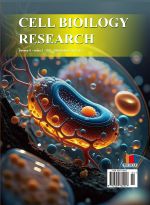Transcriptome Sequencing Analysis of Nasopharyngeal Carcinoma 5-8F Cells Induced by Timosaponin A-III
DOI:
https://doi.org/10.18063/cbr.v6i2.909Keywords:
Nasopharyngeal carcinoma, Timosaponin A-III, Transcriptome sequencingAbstract
Objective: To explore the differential gene expression of nasopharyngeal carcinoma cells induced by Timosaponin A-III and conduct biological information analysis. Methods: Total RNA was extracted from nasopharyngeal carcinoma cells treated with Timosaponin A-III for transcriptome sequencing using Illumina HiSeq 2500. Differentially expressed genes (DEGs) were screened by DESeq2, and their functions and signaling pathways were explored using GO enrichment analysis and KEGG pathway analysis. Results: Differential gene expression analysis revealed 3858 DEGs, including 1077 upregulated and 2781 downregulated genes. The heatmap and volcano plot showed significant changes in the gene expression profile. GO analysis indicated that the DEGs were enriched in biological processes such as regulation of apoptosis, autophagy, lipid metabolism, and redox processes, involving cellular components like cell membrane, cytoplasm, and mitochondria, as well as molecular functions including protein binding and protein kinase activity. KEGG pathway analysis revealed significant enrichment in signaling pathways such as apoptosis, p53, and TNF. Discussion: Timosaponin A-III may exert antitumor effects by activating apoptosis pathways and the p53 pathway. The interaction of these pathways mediates the inhibitory effect on nasopharyngeal carcinoma cells. Conclusion: This study reveals that Timosaponin A-III inhibits nasopharyngeal carcinoma cells through multi-gene and multi-pathway regulation, providing a theoretical basis for further experiments.
References
Su Z, Siak P, Lwin Y, et al., 2024, Epidemiology of Nasopharyngeal Carcinoma: Current Insights and Future Outlook. Cancer Metastasis Rev, 43(3): 919–939.
Liu Q, Wang H, Chen Z, et al., 2025, Global, Regional, and National Epidemiology of Nasopharyngeal Carcinoma in Middle-Aged and Elderly Patients From 1990 to 2021. Ageing Res Rev, 104: 102613.
Sun X, Liu S, Luo M, et al., 2019, The Association Between the Development of Radiation Therapy, Image Technology, and Chemotherapy, and the Survival of Patients With Nasopharyngeal Carcinoma: A Cohort Study From 1990 to 2012. Int J Radiat Oncol Biol Phys, 105(3): 581–590.
Jiang W, Lv J, Tang L, et al., 2024, Enhancing Efficacy and Reducing Toxicity: Therapeutic Optimization in Locoregionally Advanced Nasopharyngeal Carcinoma. Cell Rep Med, 5(6): 101594.
Renault T, Teijido O, Antonsson B, et al., 2013, Regulation of Bax Mitochondrial Localization by Bcl-2 and Bcl-x(L): Keep Your Friends Close but Your Enemies Closer. Int J Biochem Cell Biol, 45(1): 64–67.
Lopez J, Tait S, 2015, Mitochondrial Apoptosis: Killing Cancer Using the Enemy Within. Br J Cancer, 112(6): 957–962.
Vogler M, Walczak H, Stadel D, et al., 2008, Targeting XIAP Bypasses Bcl-2-Mediated Resistance to TRAIL and Cooperates With TRAIL to Suppress Pancreatic Cancer Growth in Vitro and in Vivo. Cancer Res, 68(19): 7956–7965.
Liu Y, Su Z, Tavana O, Gu W, 2024, Understanding the Complexity of p53 in a New Era of Tumor Suppression. Cancer Cell, 42(6): 946–967.
Lee Y, Vafaeinik F, Mouakkad L, et al., 2025, Mcl-1 Is a Gatekeeper Molecule to Regulate the Crosstalk Between Ferroptotic Agent-Induced ER Stress and TRAIL-Induced Apoptosis. J Cell Biochem, 126(1): e30681.
van Heemst D, Mooijaart S, Beekman M, et al., 2005, Variation in the Human TP53 Gene Affects Old Age Survival and Cancer Mortality. Exp Gerontol, 40(1–2): 11–15.
Storey A, Thomas M, Kalita A, et al., 1998, Role of a p53 Polymorphism in the Development of Human Papillomavirus-Associated Cancer. Nature, 393(6682): 229–234.
Hainaut P, Pfeifer G, 2016, Somatic TP53 Mutations in the Era of Genome Sequencing. Cold Spring Harb Perspect Med, 6(11): a026179.

